Critical Analysis: Independent Auditor's Report on Westpac Group
VerifiedAdded on 2023/01/23
|10
|3238
|87
Report
AI Summary
This report provides a critical analysis of an independent auditor's report, specifically focusing on the financial statements of Westpac Group, an ASX-listed company, for the fiscal year ended June 30, 2018. The analysis centers on key audit matters (KAM) as outlined in the new Auditing Standard ASA 701. The report delves into two primary KAMs: the evaluation of liability accuracy concerning Australian banknotes, considering their valuation in assets and liabilities, and the valuation of foreign currencies and Australian dollar investments. The report details the rationale behind ASA 701, the auditor's opinion, the basis for that opinion, and the procedures used to address each KAM, including tests of key controls and assessments of banknote movements. The report also discusses the going concern assessment and other relevant financial information. The analysis highlights the auditor's responsibilities and provides recommendations. The report emphasizes the importance of these audits in maintaining financial stability and transparency, using the Lehman Brothers bankruptcy as a cautionary example.

Independent Auditor’s Report1
RESEARCH, CRITICALLY ANALYSE AND EVALUATE KEY AUDIT MATTERS IN
INDEPENDENT AUDITOR’S REPORT
By Student’s Name
Course Code and Name
Professor’s Name
Institution Affiliation
Date
RESEARCH, CRITICALLY ANALYSE AND EVALUATE KEY AUDIT MATTERS IN
INDEPENDENT AUDITOR’S REPORT
By Student’s Name
Course Code and Name
Professor’s Name
Institution Affiliation
Date
Paraphrase This Document
Need a fresh take? Get an instant paraphrase of this document with our AI Paraphraser

Independent Auditor’s Report2
Executive Summary
This report includes an independent audit analysis accompanying intervening integrated
financial statements of an ASX-listed company (Westpac Group). In the report, key audit
matters will be included based on the auditing standard (ASA 701) that presents key audit
matters in an independent audit report, including an associated balance sheet ended 30th June
2018. One of the key audit matters include the evaluation of liability accuracy based on the
Australian banknote reference according to financial policies introduced by the federal
government. The balance of the Australia banknote issued signifies the valuation of all the
relevant banknotes on liability and assets calculated to be $879,592 in total assets and
$815,019 in total liabilities (Qiao, Vo and Zhu, 2019). These valuations is analysed in
consideration to the relative Australian banknotes provided minimal banknotes deducted from
exchange. The second key matter concerns the valuation of foreign currencies and the
Australian dollar investment. This key audit matter has been referenced from the board’s
Financial Risks & Instruments and The Accounting Policies notes. The evaluation of foreign
currencies and the Australian dollar investments are key auditing matters because of their
relevant impacts in reference to the company’s position of financial statements, including the
complications apparent in auditing of wide-ranged investments data which compel the
presentation of financial estimation measures.
Executive Summary
This report includes an independent audit analysis accompanying intervening integrated
financial statements of an ASX-listed company (Westpac Group). In the report, key audit
matters will be included based on the auditing standard (ASA 701) that presents key audit
matters in an independent audit report, including an associated balance sheet ended 30th June
2018. One of the key audit matters include the evaluation of liability accuracy based on the
Australian banknote reference according to financial policies introduced by the federal
government. The balance of the Australia banknote issued signifies the valuation of all the
relevant banknotes on liability and assets calculated to be $879,592 in total assets and
$815,019 in total liabilities (Qiao, Vo and Zhu, 2019). These valuations is analysed in
consideration to the relative Australian banknotes provided minimal banknotes deducted from
exchange. The second key matter concerns the valuation of foreign currencies and the
Australian dollar investment. This key audit matter has been referenced from the board’s
Financial Risks & Instruments and The Accounting Policies notes. The evaluation of foreign
currencies and the Australian dollar investments are key auditing matters because of their
relevant impacts in reference to the company’s position of financial statements, including the
complications apparent in auditing of wide-ranged investments data which compel the
presentation of financial estimation measures.
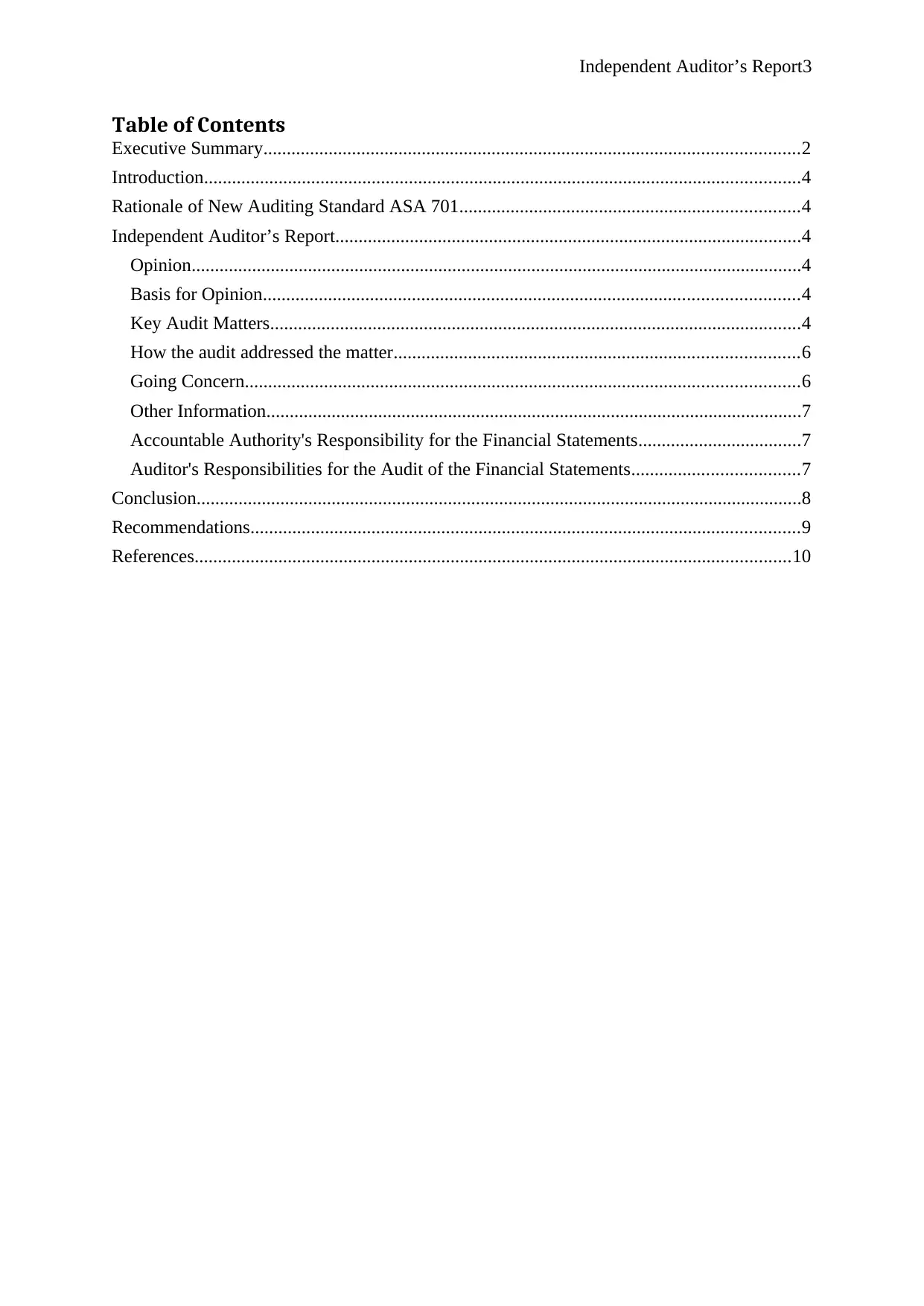
Independent Auditor’s Report3
Table of Contents
Executive Summary...................................................................................................................2
Introduction................................................................................................................................4
Rationale of New Auditing Standard ASA 701.........................................................................4
Independent Auditor’s Report....................................................................................................4
Opinion...................................................................................................................................4
Basis for Opinion...................................................................................................................4
Key Audit Matters..................................................................................................................4
How the audit addressed the matter.......................................................................................6
Going Concern.......................................................................................................................6
Other Information...................................................................................................................7
Accountable Authority's Responsibility for the Financial Statements...................................7
Auditor's Responsibilities for the Audit of the Financial Statements....................................7
Conclusion..................................................................................................................................8
Recommendations......................................................................................................................9
References................................................................................................................................10
Table of Contents
Executive Summary...................................................................................................................2
Introduction................................................................................................................................4
Rationale of New Auditing Standard ASA 701.........................................................................4
Independent Auditor’s Report....................................................................................................4
Opinion...................................................................................................................................4
Basis for Opinion...................................................................................................................4
Key Audit Matters..................................................................................................................4
How the audit addressed the matter.......................................................................................6
Going Concern.......................................................................................................................6
Other Information...................................................................................................................7
Accountable Authority's Responsibility for the Financial Statements...................................7
Auditor's Responsibilities for the Audit of the Financial Statements....................................7
Conclusion..................................................................................................................................8
Recommendations......................................................................................................................9
References................................................................................................................................10
⊘ This is a preview!⊘
Do you want full access?
Subscribe today to unlock all pages.

Trusted by 1+ million students worldwide
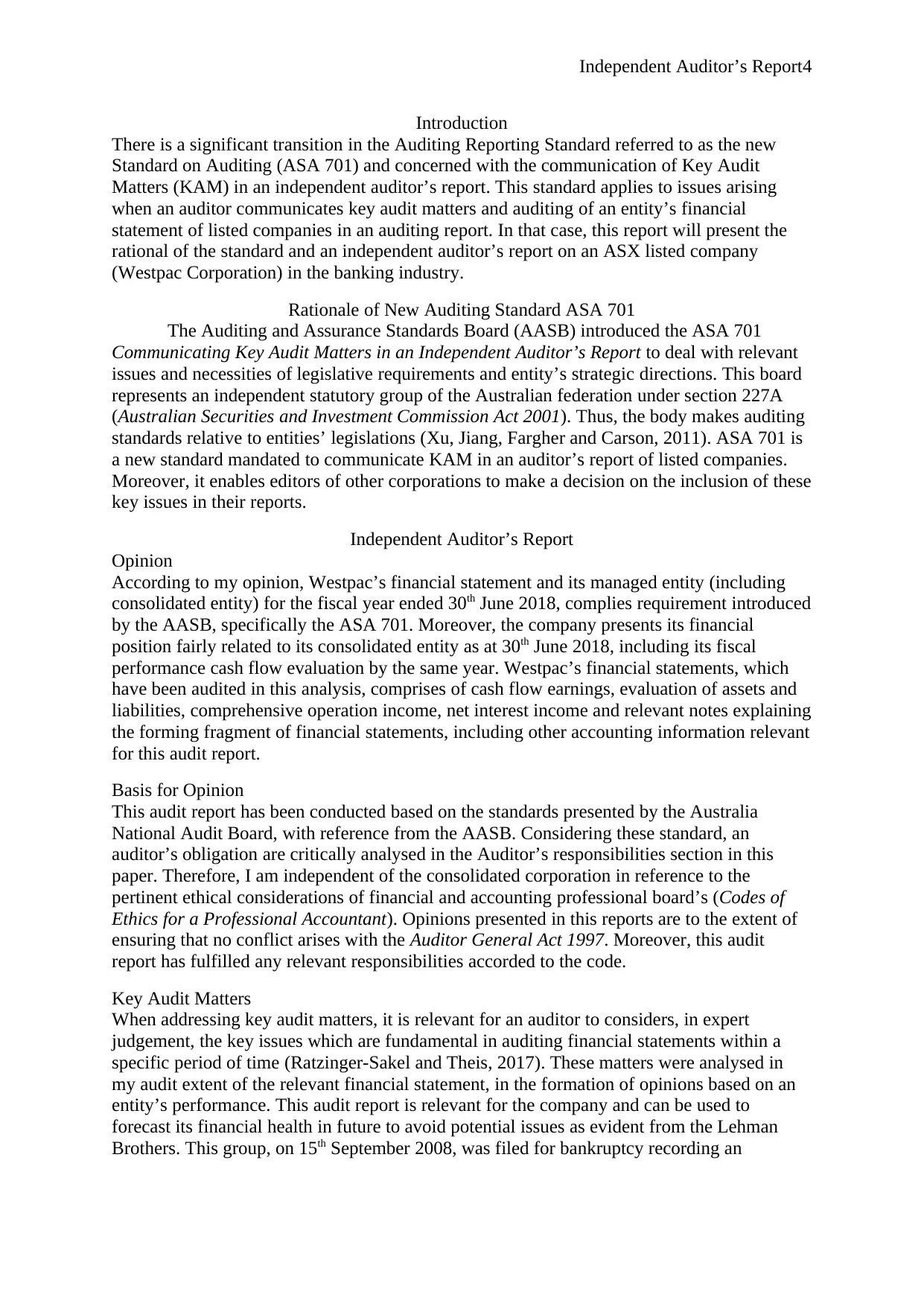
Independent Auditor’s Report4
Introduction
There is a significant transition in the Auditing Reporting Standard referred to as the new
Standard on Auditing (ASA 701) and concerned with the communication of Key Audit
Matters (KAM) in an independent auditor’s report. This standard applies to issues arising
when an auditor communicates key audit matters and auditing of an entity’s financial
statement of listed companies in an auditing report. In that case, this report will present the
rational of the standard and an independent auditor’s report on an ASX listed company
(Westpac Corporation) in the banking industry.
Rationale of New Auditing Standard ASA 701
The Auditing and Assurance Standards Board (AASB) introduced the ASA 701
Communicating Key Audit Matters in an Independent Auditor’s Report to deal with relevant
issues and necessities of legislative requirements and entity’s strategic directions. This board
represents an independent statutory group of the Australian federation under section 227A
(Australian Securities and Investment Commission Act 2001). Thus, the body makes auditing
standards relative to entities’ legislations (Xu, Jiang, Fargher and Carson, 2011). ASA 701 is
a new standard mandated to communicate KAM in an auditor’s report of listed companies.
Moreover, it enables editors of other corporations to make a decision on the inclusion of these
key issues in their reports.
Independent Auditor’s Report
Opinion
According to my opinion, Westpac’s financial statement and its managed entity (including
consolidated entity) for the fiscal year ended 30th June 2018, complies requirement introduced
by the AASB, specifically the ASA 701. Moreover, the company presents its financial
position fairly related to its consolidated entity as at 30th June 2018, including its fiscal
performance cash flow evaluation by the same year. Westpac’s financial statements, which
have been audited in this analysis, comprises of cash flow earnings, evaluation of assets and
liabilities, comprehensive operation income, net interest income and relevant notes explaining
the forming fragment of financial statements, including other accounting information relevant
for this audit report.
Basis for Opinion
This audit report has been conducted based on the standards presented by the Australia
National Audit Board, with reference from the AASB. Considering these standard, an
auditor’s obligation are critically analysed in the Auditor’s responsibilities section in this
paper. Therefore, I am independent of the consolidated corporation in reference to the
pertinent ethical considerations of financial and accounting professional board’s (Codes of
Ethics for a Professional Accountant). Opinions presented in this reports are to the extent of
ensuring that no conflict arises with the Auditor General Act 1997. Moreover, this audit
report has fulfilled any relevant responsibilities accorded to the code.
Key Audit Matters
When addressing key audit matters, it is relevant for an auditor to considers, in expert
judgement, the key issues which are fundamental in auditing financial statements within a
specific period of time (Ratzinger-Sakel and Theis, 2017). These matters were analysed in
my audit extent of the relevant financial statement, in the formation of opinions based on an
entity’s performance. This audit report is relevant for the company and can be used to
forecast its financial health in future to avoid potential issues as evident from the Lehman
Brothers. This group, on 15th September 2008, was filed for bankruptcy recording an
Introduction
There is a significant transition in the Auditing Reporting Standard referred to as the new
Standard on Auditing (ASA 701) and concerned with the communication of Key Audit
Matters (KAM) in an independent auditor’s report. This standard applies to issues arising
when an auditor communicates key audit matters and auditing of an entity’s financial
statement of listed companies in an auditing report. In that case, this report will present the
rational of the standard and an independent auditor’s report on an ASX listed company
(Westpac Corporation) in the banking industry.
Rationale of New Auditing Standard ASA 701
The Auditing and Assurance Standards Board (AASB) introduced the ASA 701
Communicating Key Audit Matters in an Independent Auditor’s Report to deal with relevant
issues and necessities of legislative requirements and entity’s strategic directions. This board
represents an independent statutory group of the Australian federation under section 227A
(Australian Securities and Investment Commission Act 2001). Thus, the body makes auditing
standards relative to entities’ legislations (Xu, Jiang, Fargher and Carson, 2011). ASA 701 is
a new standard mandated to communicate KAM in an auditor’s report of listed companies.
Moreover, it enables editors of other corporations to make a decision on the inclusion of these
key issues in their reports.
Independent Auditor’s Report
Opinion
According to my opinion, Westpac’s financial statement and its managed entity (including
consolidated entity) for the fiscal year ended 30th June 2018, complies requirement introduced
by the AASB, specifically the ASA 701. Moreover, the company presents its financial
position fairly related to its consolidated entity as at 30th June 2018, including its fiscal
performance cash flow evaluation by the same year. Westpac’s financial statements, which
have been audited in this analysis, comprises of cash flow earnings, evaluation of assets and
liabilities, comprehensive operation income, net interest income and relevant notes explaining
the forming fragment of financial statements, including other accounting information relevant
for this audit report.
Basis for Opinion
This audit report has been conducted based on the standards presented by the Australia
National Audit Board, with reference from the AASB. Considering these standard, an
auditor’s obligation are critically analysed in the Auditor’s responsibilities section in this
paper. Therefore, I am independent of the consolidated corporation in reference to the
pertinent ethical considerations of financial and accounting professional board’s (Codes of
Ethics for a Professional Accountant). Opinions presented in this reports are to the extent of
ensuring that no conflict arises with the Auditor General Act 1997. Moreover, this audit
report has fulfilled any relevant responsibilities accorded to the code.
Key Audit Matters
When addressing key audit matters, it is relevant for an auditor to considers, in expert
judgement, the key issues which are fundamental in auditing financial statements within a
specific period of time (Ratzinger-Sakel and Theis, 2017). These matters were analysed in
my audit extent of the relevant financial statement, in the formation of opinions based on an
entity’s performance. This audit report is relevant for the company and can be used to
forecast its financial health in future to avoid potential issues as evident from the Lehman
Brothers. This group, on 15th September 2008, was filed for bankruptcy recording an
Paraphrase This Document
Need a fresh take? Get an instant paraphrase of this document with our AI Paraphraser
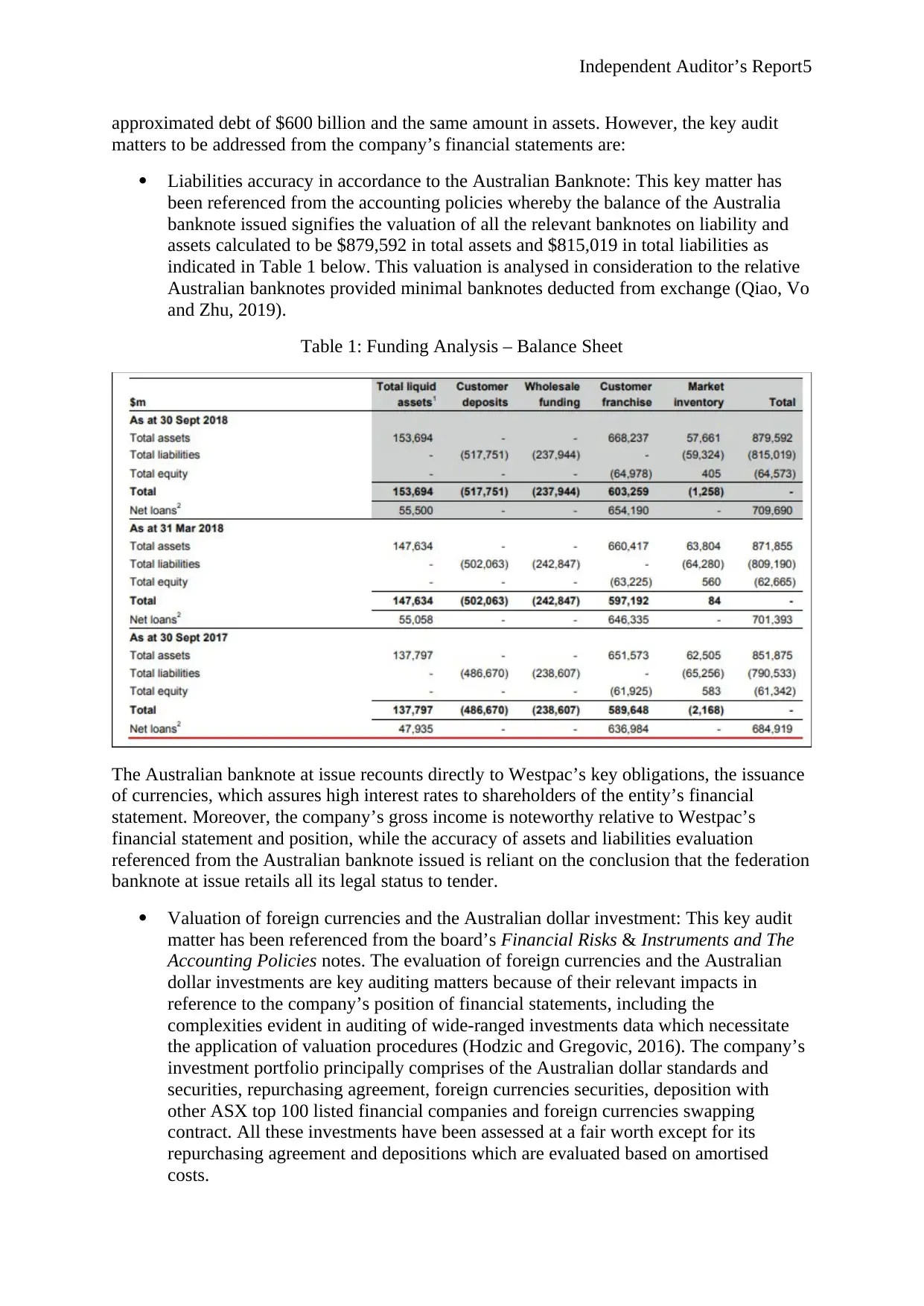
Independent Auditor’s Report5
approximated debt of $600 billion and the same amount in assets. However, the key audit
matters to be addressed from the company’s financial statements are:
Liabilities accuracy in accordance to the Australian Banknote: This key matter has
been referenced from the accounting policies whereby the balance of the Australia
banknote issued signifies the valuation of all the relevant banknotes on liability and
assets calculated to be $879,592 in total assets and $815,019 in total liabilities as
indicated in Table 1 below. This valuation is analysed in consideration to the relative
Australian banknotes provided minimal banknotes deducted from exchange (Qiao, Vo
and Zhu, 2019).
Table 1: Funding Analysis – Balance Sheet
The Australian banknote at issue recounts directly to Westpac’s key obligations, the issuance
of currencies, which assures high interest rates to shareholders of the entity’s financial
statement. Moreover, the company’s gross income is noteworthy relative to Westpac’s
financial statement and position, while the accuracy of assets and liabilities evaluation
referenced from the Australian banknote issued is reliant on the conclusion that the federation
banknote at issue retails all its legal status to tender.
Valuation of foreign currencies and the Australian dollar investment: This key audit
matter has been referenced from the board’s Financial Risks & Instruments and The
Accounting Policies notes. The evaluation of foreign currencies and the Australian
dollar investments are key auditing matters because of their relevant impacts in
reference to the company’s position of financial statements, including the
complexities evident in auditing of wide-ranged investments data which necessitate
the application of valuation procedures (Hodzic and Gregovic, 2016). The company’s
investment portfolio principally comprises of the Australian dollar standards and
securities, repurchasing agreement, foreign currencies securities, deposition with
other ASX top 100 listed financial companies and foreign currencies swapping
contract. All these investments have been assessed at a fair worth except for its
repurchasing agreement and depositions which are evaluated based on amortised
costs.
approximated debt of $600 billion and the same amount in assets. However, the key audit
matters to be addressed from the company’s financial statements are:
Liabilities accuracy in accordance to the Australian Banknote: This key matter has
been referenced from the accounting policies whereby the balance of the Australia
banknote issued signifies the valuation of all the relevant banknotes on liability and
assets calculated to be $879,592 in total assets and $815,019 in total liabilities as
indicated in Table 1 below. This valuation is analysed in consideration to the relative
Australian banknotes provided minimal banknotes deducted from exchange (Qiao, Vo
and Zhu, 2019).
Table 1: Funding Analysis – Balance Sheet
The Australian banknote at issue recounts directly to Westpac’s key obligations, the issuance
of currencies, which assures high interest rates to shareholders of the entity’s financial
statement. Moreover, the company’s gross income is noteworthy relative to Westpac’s
financial statement and position, while the accuracy of assets and liabilities evaluation
referenced from the Australian banknote issued is reliant on the conclusion that the federation
banknote at issue retails all its legal status to tender.
Valuation of foreign currencies and the Australian dollar investment: This key audit
matter has been referenced from the board’s Financial Risks & Instruments and The
Accounting Policies notes. The evaluation of foreign currencies and the Australian
dollar investments are key auditing matters because of their relevant impacts in
reference to the company’s position of financial statements, including the
complexities evident in auditing of wide-ranged investments data which necessitate
the application of valuation procedures (Hodzic and Gregovic, 2016). The company’s
investment portfolio principally comprises of the Australian dollar standards and
securities, repurchasing agreement, foreign currencies securities, deposition with
other ASX top 100 listed financial companies and foreign currencies swapping
contract. All these investments have been assessed at a fair worth except for its
repurchasing agreement and depositions which are evaluated based on amortised
costs.
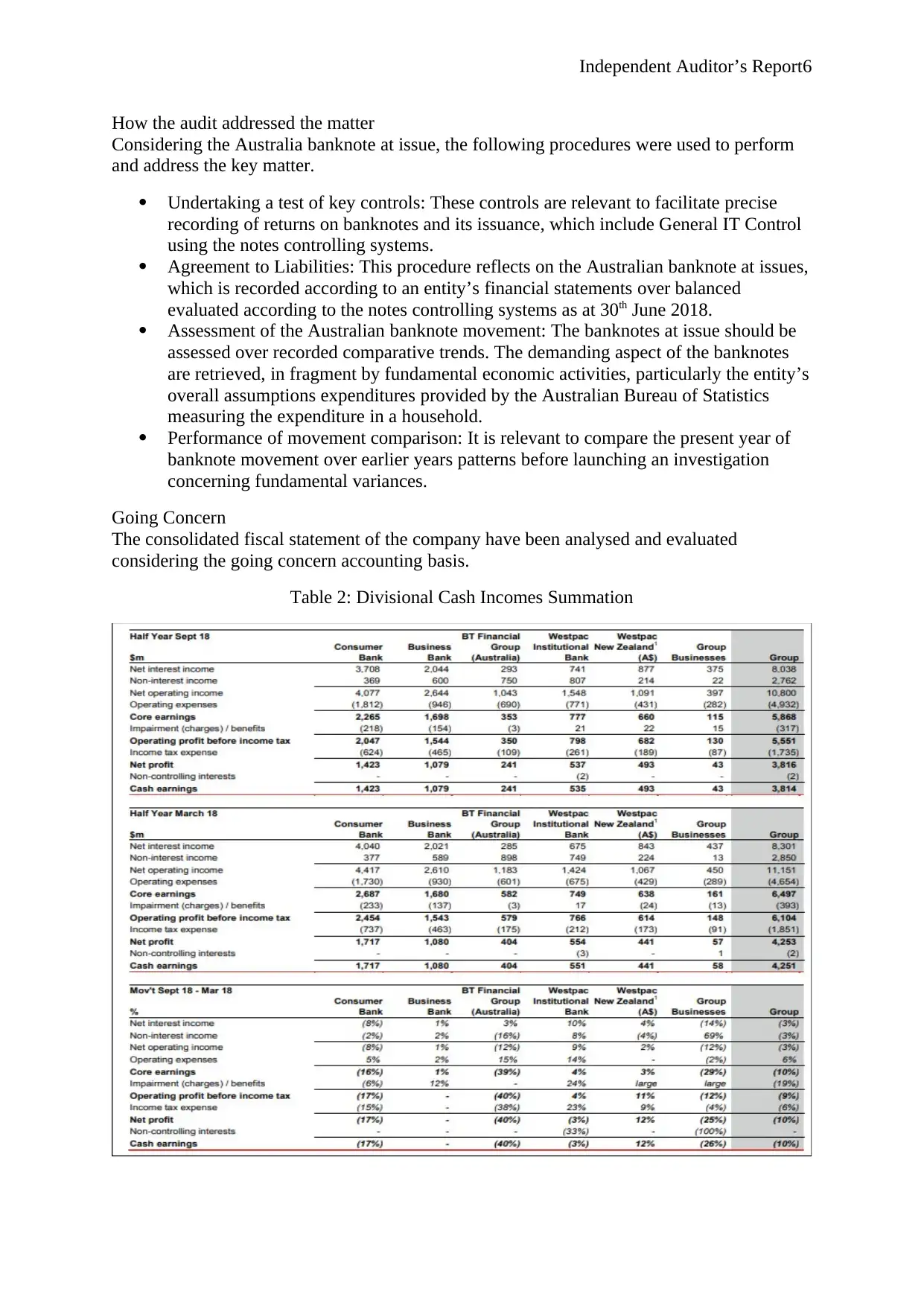
Independent Auditor’s Report6
How the audit addressed the matter
Considering the Australia banknote at issue, the following procedures were used to perform
and address the key matter.
Undertaking a test of key controls: These controls are relevant to facilitate precise
recording of returns on banknotes and its issuance, which include General IT Control
using the notes controlling systems.
Agreement to Liabilities: This procedure reflects on the Australian banknote at issues,
which is recorded according to an entity’s financial statements over balanced
evaluated according to the notes controlling systems as at 30th June 2018.
Assessment of the Australian banknote movement: The banknotes at issue should be
assessed over recorded comparative trends. The demanding aspect of the banknotes
are retrieved, in fragment by fundamental economic activities, particularly the entity’s
overall assumptions expenditures provided by the Australian Bureau of Statistics
measuring the expenditure in a household.
Performance of movement comparison: It is relevant to compare the present year of
banknote movement over earlier years patterns before launching an investigation
concerning fundamental variances.
Going Concern
The consolidated fiscal statement of the company have been analysed and evaluated
considering the going concern accounting basis.
Table 2: Divisional Cash Incomes Summation
How the audit addressed the matter
Considering the Australia banknote at issue, the following procedures were used to perform
and address the key matter.
Undertaking a test of key controls: These controls are relevant to facilitate precise
recording of returns on banknotes and its issuance, which include General IT Control
using the notes controlling systems.
Agreement to Liabilities: This procedure reflects on the Australian banknote at issues,
which is recorded according to an entity’s financial statements over balanced
evaluated according to the notes controlling systems as at 30th June 2018.
Assessment of the Australian banknote movement: The banknotes at issue should be
assessed over recorded comparative trends. The demanding aspect of the banknotes
are retrieved, in fragment by fundamental economic activities, particularly the entity’s
overall assumptions expenditures provided by the Australian Bureau of Statistics
measuring the expenditure in a household.
Performance of movement comparison: It is relevant to compare the present year of
banknote movement over earlier years patterns before launching an investigation
concerning fundamental variances.
Going Concern
The consolidated fiscal statement of the company have been analysed and evaluated
considering the going concern accounting basis.
Table 2: Divisional Cash Incomes Summation
⊘ This is a preview!⊘
Do you want full access?
Subscribe today to unlock all pages.

Trusted by 1+ million students worldwide
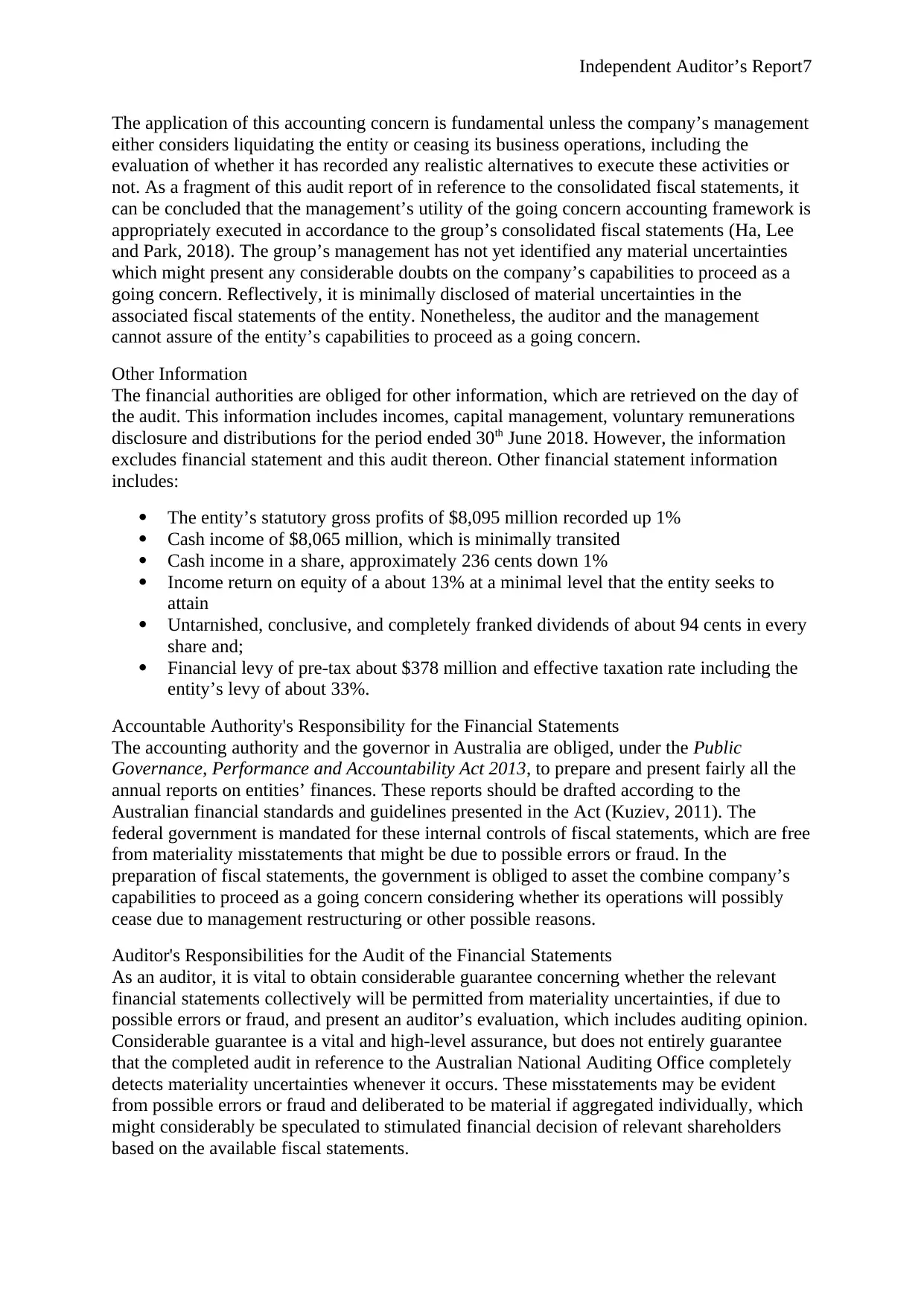
Independent Auditor’s Report7
The application of this accounting concern is fundamental unless the company’s management
either considers liquidating the entity or ceasing its business operations, including the
evaluation of whether it has recorded any realistic alternatives to execute these activities or
not. As a fragment of this audit report of in reference to the consolidated fiscal statements, it
can be concluded that the management’s utility of the going concern accounting framework is
appropriately executed in accordance to the group’s consolidated fiscal statements (Ha, Lee
and Park, 2018). The group’s management has not yet identified any material uncertainties
which might present any considerable doubts on the company’s capabilities to proceed as a
going concern. Reflectively, it is minimally disclosed of material uncertainties in the
associated fiscal statements of the entity. Nonetheless, the auditor and the management
cannot assure of the entity’s capabilities to proceed as a going concern.
Other Information
The financial authorities are obliged for other information, which are retrieved on the day of
the audit. This information includes incomes, capital management, voluntary remunerations
disclosure and distributions for the period ended 30th June 2018. However, the information
excludes financial statement and this audit thereon. Other financial statement information
includes:
The entity’s statutory gross profits of $8,095 million recorded up 1%
Cash income of $8,065 million, which is minimally transited
Cash income in a share, approximately 236 cents down 1%
Income return on equity of a about 13% at a minimal level that the entity seeks to
attain
Untarnished, conclusive, and completely franked dividends of about 94 cents in every
share and;
Financial levy of pre-tax about $378 million and effective taxation rate including the
entity’s levy of about 33%.
Accountable Authority's Responsibility for the Financial Statements
The accounting authority and the governor in Australia are obliged, under the Public
Governance, Performance and Accountability Act 2013, to prepare and present fairly all the
annual reports on entities’ finances. These reports should be drafted according to the
Australian financial standards and guidelines presented in the Act (Kuziev, 2011). The
federal government is mandated for these internal controls of fiscal statements, which are free
from materiality misstatements that might be due to possible errors or fraud. In the
preparation of fiscal statements, the government is obliged to asset the combine company’s
capabilities to proceed as a going concern considering whether its operations will possibly
cease due to management restructuring or other possible reasons.
Auditor's Responsibilities for the Audit of the Financial Statements
As an auditor, it is vital to obtain considerable guarantee concerning whether the relevant
financial statements collectively will be permitted from materiality uncertainties, if due to
possible errors or fraud, and present an auditor’s evaluation, which includes auditing opinion.
Considerable guarantee is a vital and high-level assurance, but does not entirely guarantee
that the completed audit in reference to the Australian National Auditing Office completely
detects materiality uncertainties whenever it occurs. These misstatements may be evident
from possible errors or fraud and deliberated to be material if aggregated individually, which
might considerably be speculated to stimulated financial decision of relevant shareholders
based on the available fiscal statements.
The application of this accounting concern is fundamental unless the company’s management
either considers liquidating the entity or ceasing its business operations, including the
evaluation of whether it has recorded any realistic alternatives to execute these activities or
not. As a fragment of this audit report of in reference to the consolidated fiscal statements, it
can be concluded that the management’s utility of the going concern accounting framework is
appropriately executed in accordance to the group’s consolidated fiscal statements (Ha, Lee
and Park, 2018). The group’s management has not yet identified any material uncertainties
which might present any considerable doubts on the company’s capabilities to proceed as a
going concern. Reflectively, it is minimally disclosed of material uncertainties in the
associated fiscal statements of the entity. Nonetheless, the auditor and the management
cannot assure of the entity’s capabilities to proceed as a going concern.
Other Information
The financial authorities are obliged for other information, which are retrieved on the day of
the audit. This information includes incomes, capital management, voluntary remunerations
disclosure and distributions for the period ended 30th June 2018. However, the information
excludes financial statement and this audit thereon. Other financial statement information
includes:
The entity’s statutory gross profits of $8,095 million recorded up 1%
Cash income of $8,065 million, which is minimally transited
Cash income in a share, approximately 236 cents down 1%
Income return on equity of a about 13% at a minimal level that the entity seeks to
attain
Untarnished, conclusive, and completely franked dividends of about 94 cents in every
share and;
Financial levy of pre-tax about $378 million and effective taxation rate including the
entity’s levy of about 33%.
Accountable Authority's Responsibility for the Financial Statements
The accounting authority and the governor in Australia are obliged, under the Public
Governance, Performance and Accountability Act 2013, to prepare and present fairly all the
annual reports on entities’ finances. These reports should be drafted according to the
Australian financial standards and guidelines presented in the Act (Kuziev, 2011). The
federal government is mandated for these internal controls of fiscal statements, which are free
from materiality misstatements that might be due to possible errors or fraud. In the
preparation of fiscal statements, the government is obliged to asset the combine company’s
capabilities to proceed as a going concern considering whether its operations will possibly
cease due to management restructuring or other possible reasons.
Auditor's Responsibilities for the Audit of the Financial Statements
As an auditor, it is vital to obtain considerable guarantee concerning whether the relevant
financial statements collectively will be permitted from materiality uncertainties, if due to
possible errors or fraud, and present an auditor’s evaluation, which includes auditing opinion.
Considerable guarantee is a vital and high-level assurance, but does not entirely guarantee
that the completed audit in reference to the Australian National Auditing Office completely
detects materiality uncertainties whenever it occurs. These misstatements may be evident
from possible errors or fraud and deliberated to be material if aggregated individually, which
might considerably be speculated to stimulated financial decision of relevant shareholders
based on the available fiscal statements.
Paraphrase This Document
Need a fresh take? Get an instant paraphrase of this document with our AI Paraphraser

Independent Auditor’s Report8
As a fragment of auditing referenced from the Auditing office and its standard, it is vital to
present expert judgement, while maintaining professional cynicism throughout this audit
report. Thus, it is relevant to:
Assess the identified hazards of materiality uncertainties of the overall financial
statements, that are evident due to possible errors or fraud before designing and
performing auditing procedures approachable using these threats to obtain sufficient
auditing evidence appropriate to presenting professional opinion. The problem of not
identifying these uncertainties resultant from fraud is greater compared to risks
realized from errors; this is due to the assumption that fraud involve forgery,
collusion, data misinterpretation, intentional deduction and overriding the entity’s
internal control (Zalata, Tauringana and Tingbani, 2018).
Attain full understanding of the entity’s internal control, which is fundamental for the
overall audit that is meant to design an acceptable auditing procedure. These
procedures are relevant in various financial conditions, but not intended to present
audit opinions on the efficacy of integrated company’s internal controls.
Considering the evaluation of financial policy efficacy applied, including the
rationality of the relevant financial approximations and correlated disclosures by the
relevant accounting authorities.
Complete on the correctness of accounting authorities’ relevance based on the going
concern accounting framework, including the basis of auditing indication provided.
This includes an evaluation of whether the materiality uncertainty occurs correlated to
conditions and events casting fundamental suspicion on the integrated company’s
capabilities to proceed as a going concern. Concluding that the materiality
uncertainties prevail, it is relevant to draw significant responsiveness in this auditor’s
analysis to correlated disclosures in the fiscal statements or, whether these disclosures
are insufficient to transform this audit opinion. The findings are centred on auditing
evidence until the date of this audit analysis. Nonetheless, future conditions and evens
may possibly affect the integrated entity to terminate its continuity to proceed as a
going concern (Fakhfakh, 2015).
Evaluating the collective structure and presentation of the statement’s context, which
includes financial disclosures, and if the accounting statements signify principal
events and transactions designed to attain fair data presentation, and
Obtaining effective audit evidence concerning the relevant financial data of various
top 100 entities listed by ASX within the banking industry to provide expert opinion
on fiscal reports. Thus, this audit entails a presentation of future directions,
performance and supervisions purposed on consolidated company audit, which draws
the relevance of remaining completely responsible for opinions presented in the audit.
Moreover, maintaining communication with the authorities tasked with governance of
key matters, premediated timing and audit scope is fundamental for presenting
professional audit conclusions as presented by Alali and Romero (2013), which
entails any relevant uncertainties in the entity’s internal control identified in this audit.
Conclusion
Key audit matters presented in this independent audit report are communicated considering
other relevant issues charged with governance. This report has presented the matters that
were of utmost implication in the exercise of auditing the company’s financial reports as at
30th June 2018. Thus, these key matters should be communicated due the current issues,
which might have a significant impact on the entity’s financial performance, evident in the
banking industry.
As a fragment of auditing referenced from the Auditing office and its standard, it is vital to
present expert judgement, while maintaining professional cynicism throughout this audit
report. Thus, it is relevant to:
Assess the identified hazards of materiality uncertainties of the overall financial
statements, that are evident due to possible errors or fraud before designing and
performing auditing procedures approachable using these threats to obtain sufficient
auditing evidence appropriate to presenting professional opinion. The problem of not
identifying these uncertainties resultant from fraud is greater compared to risks
realized from errors; this is due to the assumption that fraud involve forgery,
collusion, data misinterpretation, intentional deduction and overriding the entity’s
internal control (Zalata, Tauringana and Tingbani, 2018).
Attain full understanding of the entity’s internal control, which is fundamental for the
overall audit that is meant to design an acceptable auditing procedure. These
procedures are relevant in various financial conditions, but not intended to present
audit opinions on the efficacy of integrated company’s internal controls.
Considering the evaluation of financial policy efficacy applied, including the
rationality of the relevant financial approximations and correlated disclosures by the
relevant accounting authorities.
Complete on the correctness of accounting authorities’ relevance based on the going
concern accounting framework, including the basis of auditing indication provided.
This includes an evaluation of whether the materiality uncertainty occurs correlated to
conditions and events casting fundamental suspicion on the integrated company’s
capabilities to proceed as a going concern. Concluding that the materiality
uncertainties prevail, it is relevant to draw significant responsiveness in this auditor’s
analysis to correlated disclosures in the fiscal statements or, whether these disclosures
are insufficient to transform this audit opinion. The findings are centred on auditing
evidence until the date of this audit analysis. Nonetheless, future conditions and evens
may possibly affect the integrated entity to terminate its continuity to proceed as a
going concern (Fakhfakh, 2015).
Evaluating the collective structure and presentation of the statement’s context, which
includes financial disclosures, and if the accounting statements signify principal
events and transactions designed to attain fair data presentation, and
Obtaining effective audit evidence concerning the relevant financial data of various
top 100 entities listed by ASX within the banking industry to provide expert opinion
on fiscal reports. Thus, this audit entails a presentation of future directions,
performance and supervisions purposed on consolidated company audit, which draws
the relevance of remaining completely responsible for opinions presented in the audit.
Moreover, maintaining communication with the authorities tasked with governance of
key matters, premediated timing and audit scope is fundamental for presenting
professional audit conclusions as presented by Alali and Romero (2013), which
entails any relevant uncertainties in the entity’s internal control identified in this audit.
Conclusion
Key audit matters presented in this independent audit report are communicated considering
other relevant issues charged with governance. This report has presented the matters that
were of utmost implication in the exercise of auditing the company’s financial reports as at
30th June 2018. Thus, these key matters should be communicated due the current issues,
which might have a significant impact on the entity’s financial performance, evident in the
banking industry.
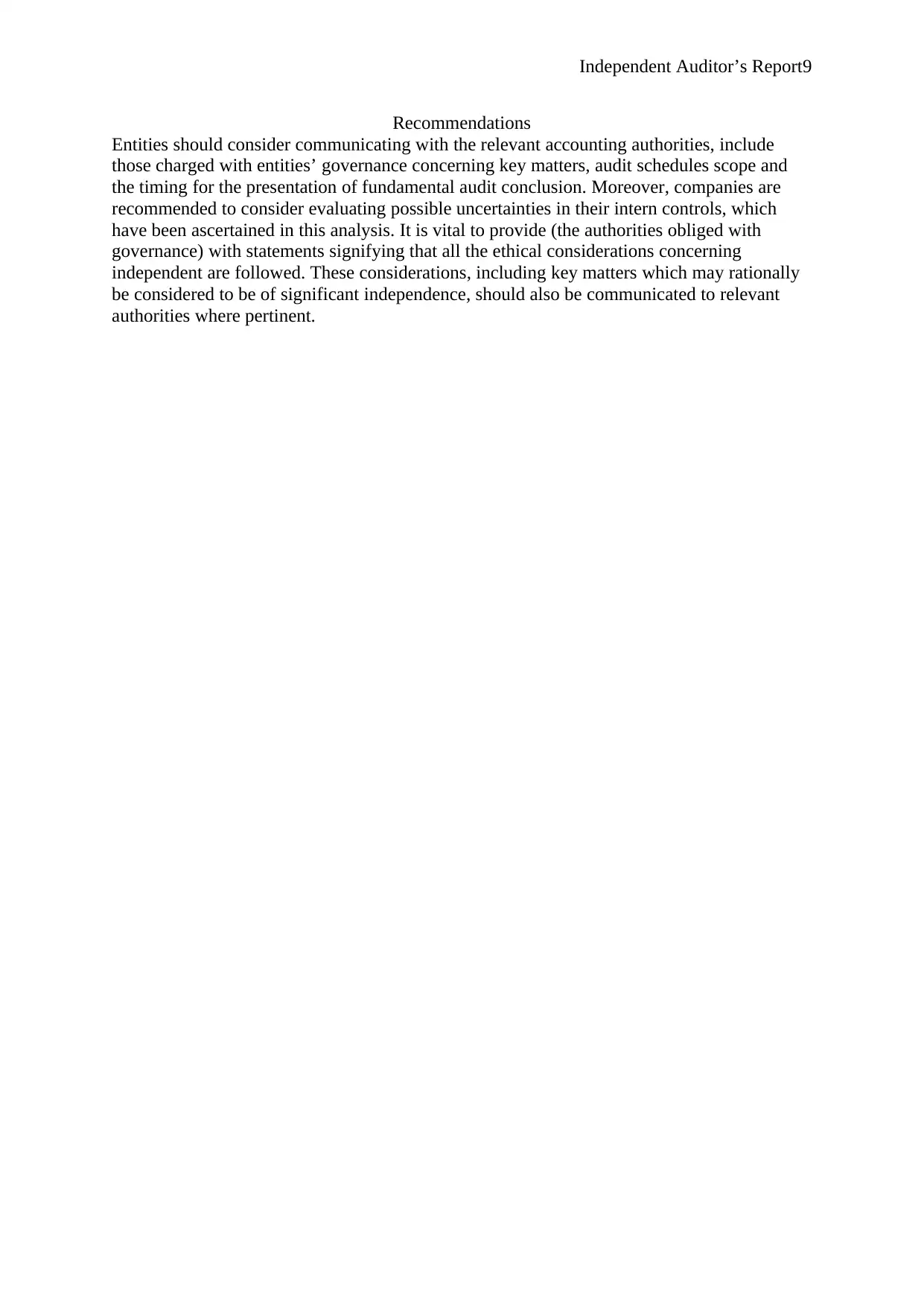
Independent Auditor’s Report9
Recommendations
Entities should consider communicating with the relevant accounting authorities, include
those charged with entities’ governance concerning key matters, audit schedules scope and
the timing for the presentation of fundamental audit conclusion. Moreover, companies are
recommended to consider evaluating possible uncertainties in their intern controls, which
have been ascertained in this analysis. It is vital to provide (the authorities obliged with
governance) with statements signifying that all the ethical considerations concerning
independent are followed. These considerations, including key matters which may rationally
be considered to be of significant independence, should also be communicated to relevant
authorities where pertinent.
Recommendations
Entities should consider communicating with the relevant accounting authorities, include
those charged with entities’ governance concerning key matters, audit schedules scope and
the timing for the presentation of fundamental audit conclusion. Moreover, companies are
recommended to consider evaluating possible uncertainties in their intern controls, which
have been ascertained in this analysis. It is vital to provide (the authorities obliged with
governance) with statements signifying that all the ethical considerations concerning
independent are followed. These considerations, including key matters which may rationally
be considered to be of significant independence, should also be communicated to relevant
authorities where pertinent.
⊘ This is a preview!⊘
Do you want full access?
Subscribe today to unlock all pages.

Trusted by 1+ million students worldwide
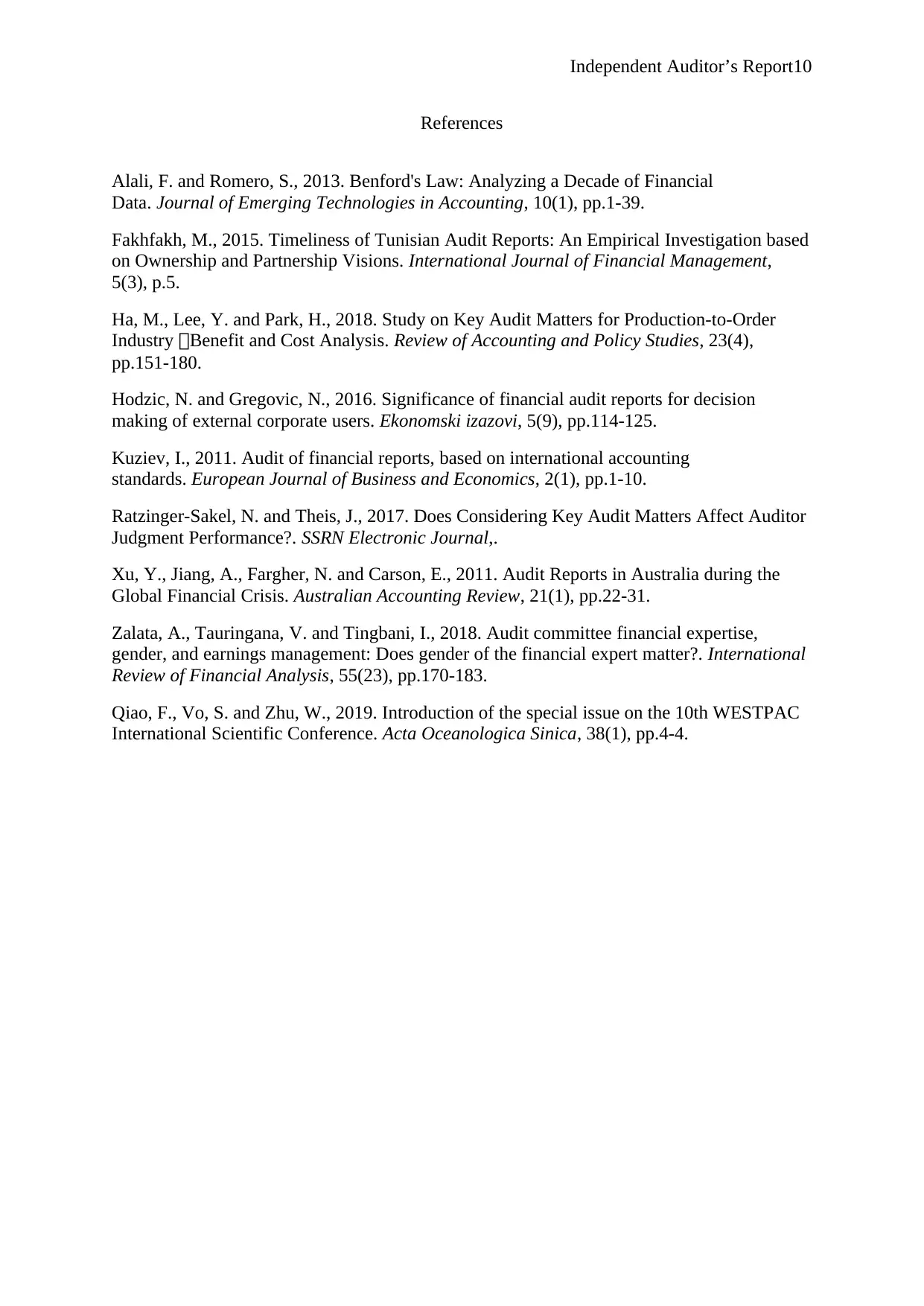
Independent Auditor’s Report10
References
Alali, F. and Romero, S., 2013. Benford's Law: Analyzing a Decade of Financial
Data. Journal of Emerging Technologies in Accounting, 10(1), pp.1-39.
Fakhfakh, M., 2015. Timeliness of Tunisian Audit Reports: An Empirical Investigation based
on Ownership and Partnership Visions. International Journal of Financial Management,
5(3), p.5.
Ha, M., Lee, Y. and Park, H., 2018. Study on Key Audit Matters for Production-to-Order
Industry :Benefit and Cost Analysis. Review of Accounting and Policy Studies, 23(4),
pp.151-180.
Hodzic, N. and Gregovic, N., 2016. Significance of financial audit reports for decision
making of external corporate users. Ekonomski izazovi, 5(9), pp.114-125.
Kuziev, I., 2011. Audit of financial reports, based on international accounting
standards. European Journal of Business and Economics, 2(1), pp.1-10.
Ratzinger-Sakel, N. and Theis, J., 2017. Does Considering Key Audit Matters Affect Auditor
Judgment Performance?. SSRN Electronic Journal,.
Xu, Y., Jiang, A., Fargher, N. and Carson, E., 2011. Audit Reports in Australia during the
Global Financial Crisis. Australian Accounting Review, 21(1), pp.22-31.
Zalata, A., Tauringana, V. and Tingbani, I., 2018. Audit committee financial expertise,
gender, and earnings management: Does gender of the financial expert matter?. International
Review of Financial Analysis, 55(23), pp.170-183.
Qiao, F., Vo, S. and Zhu, W., 2019. Introduction of the special issue on the 10th WESTPAC
International Scientific Conference. Acta Oceanologica Sinica, 38(1), pp.4-4.
References
Alali, F. and Romero, S., 2013. Benford's Law: Analyzing a Decade of Financial
Data. Journal of Emerging Technologies in Accounting, 10(1), pp.1-39.
Fakhfakh, M., 2015. Timeliness of Tunisian Audit Reports: An Empirical Investigation based
on Ownership and Partnership Visions. International Journal of Financial Management,
5(3), p.5.
Ha, M., Lee, Y. and Park, H., 2018. Study on Key Audit Matters for Production-to-Order
Industry :Benefit and Cost Analysis. Review of Accounting and Policy Studies, 23(4),
pp.151-180.
Hodzic, N. and Gregovic, N., 2016. Significance of financial audit reports for decision
making of external corporate users. Ekonomski izazovi, 5(9), pp.114-125.
Kuziev, I., 2011. Audit of financial reports, based on international accounting
standards. European Journal of Business and Economics, 2(1), pp.1-10.
Ratzinger-Sakel, N. and Theis, J., 2017. Does Considering Key Audit Matters Affect Auditor
Judgment Performance?. SSRN Electronic Journal,.
Xu, Y., Jiang, A., Fargher, N. and Carson, E., 2011. Audit Reports in Australia during the
Global Financial Crisis. Australian Accounting Review, 21(1), pp.22-31.
Zalata, A., Tauringana, V. and Tingbani, I., 2018. Audit committee financial expertise,
gender, and earnings management: Does gender of the financial expert matter?. International
Review of Financial Analysis, 55(23), pp.170-183.
Qiao, F., Vo, S. and Zhu, W., 2019. Introduction of the special issue on the 10th WESTPAC
International Scientific Conference. Acta Oceanologica Sinica, 38(1), pp.4-4.
1 out of 10
Related Documents
Your All-in-One AI-Powered Toolkit for Academic Success.
+13062052269
info@desklib.com
Available 24*7 on WhatsApp / Email
![[object Object]](/_next/static/media/star-bottom.7253800d.svg)
Unlock your academic potential
Copyright © 2020–2025 A2Z Services. All Rights Reserved. Developed and managed by ZUCOL.





